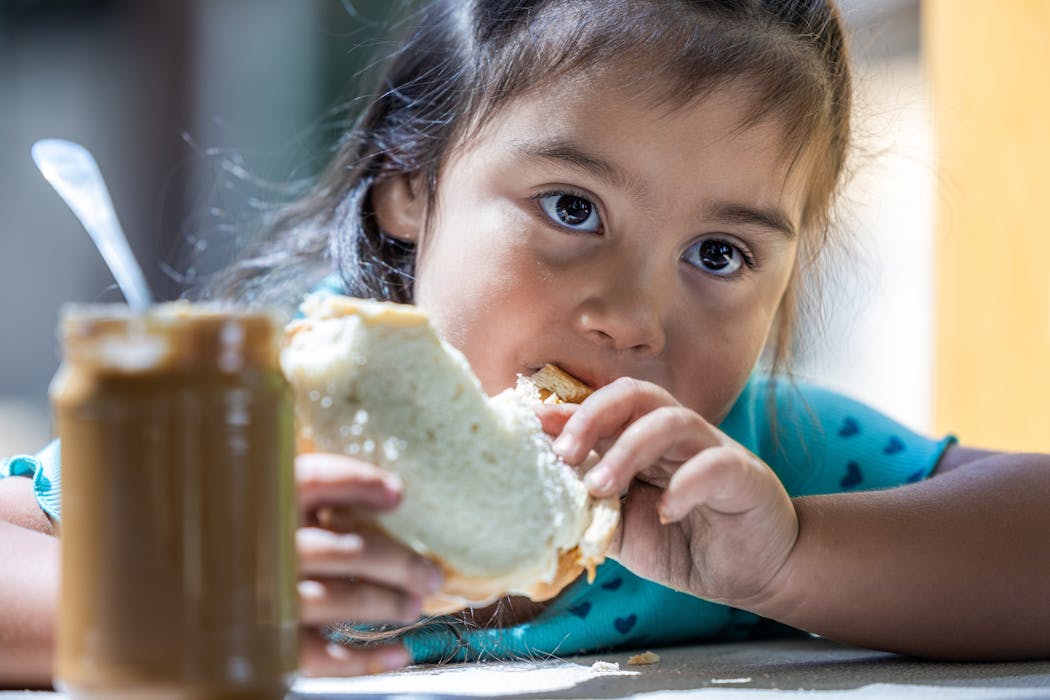
A new study published in the journal Pediatrics shows peanut allergies are becoming less common in the United States.
The authors looked at the number of children diagnosed with a peanut allergy before and after the introduction of guidelines that recommended introducing peanut products to infants in their first year of life. This reversed earlier guidelines to avoid peanuts in the first few years of life.
The study found a 43% decrease in peanut allergy diagnoses in the years after the introduction of the new guidelines.
So are we likely to see a similar decline in Australia?
When your body mistakes food as as threat
Food allergies occur when the immune system reacts to something that is usually harmless, such as a peanut, and mistakenly sees it as a threat.
Almost any food can cause an allergic reaction, but the most common food allergy triggers are peanut, egg, cow’s milk, tree nuts, sesame, soy, wheat, fish and other seafood.
Symptoms can include swelling of the face, lips or eyes, hives (welts) on the skin, vomiting, difficulty breathing and collapsing.
Read more: What's the difference between a food allergy and an intolerance?
From delayed to early consumption
One of the biggest advances in allergy prevention was recognising the importance of introducing common allergy-causing foods, such as peanuts, to infants at the right time.
In 2008, a study reported that Jewish children in the United Kingdom had higher rates of peanut allergies than Jewish children in Israel. The children in Israel more often ate peanut products in their first year of life.
The authors suggested this earlier introduction of peanuts in Israeli children’s diets might be preventing peanut allergies.
The Learning Early About Peanut Allergy (LEAP) trial tested this theory, in a study that took almost ten years to complete. The researchers randomly assigned 640 infants with eczema or an egg allergy to either:
- avoid peanut until age five years, or
- start eating peanut by age 11 months.
When the children were five years old, peanut allergies were much less common in those who started eating peanut products early compared with those who avoided them.
Children who have eczema or egg allergy are more likely to develop a peanut allergy – although peanut allergy can also occur in children without eczema or other food allergies.
What do the guidelines say now?
Following the publication of the LEAP trial findings in 2015, guidelines in the US and Australia changed to recommend giving peanut products as part of the infant diet to reduce the risk of peanut allergy.
Current Australian guidelines recommend introducing all infants to a range of common foods that can cause allergy – including peanuts – in the first year of life. Ideally this should happen soon after solid foods are introduced.
Foods should be given in a form appropriate for infants, such as smooth peanut butter mixed with purees, and in small amounts to start with.
The new guidelines are a major change from previous advice. In the 1990s and early 2000s, some guidelines in the US and Australia recommended avoiding peanut products in the first few years of life for children with a family history of allergy.
We now know this did not prevent peanut allergies and in fact may have increased the risk.
Around 2008, guidelines in Australia and the US started to change. Although advice to avoid peanut products began to be removed from guidelines, it was not until 2015 that early introduction was explicitly recommended.
What did the US study find?
The US study looked at three cohorts of around 40,000 children aged 0–3 years at three points in 2012–14, 2015–17 and 2017–19.
Peanut allergy prevalence decreased from 0.79% in the 2012-14 cohort to 0.45% in the 2017-19 cohort, a 43% decrease.
However, there are some limitations to the US study.
Food allergies were not directly measured, and instead relied on a diagnosis of food allergy recorded in a medical database.
The way food allergies are diagnosed might change over time with the development of new tests and guidelines and changing awareness of food allergy. It also means children who didn’t access care for a suspected food allergy weren’t included in the data.
The study also did not look at whether the children with and without a peanut allergy had peanut products introduced into their diet in the same way as the guidelines recommended.
What are we seeing in Australia?
We found more than eight in ten families introduced peanut products to their infants in the first year of life after the guidelines were introduced, compared with fewer than three in ten before the guidelines.
We are also starting to see a possible decrease in peanut allergy. In one study, peanut allergy decreased from 3.1% to 2.6% after the guidelines, about a 16% reduction.
Unlike the US study, all children were tested for possible peanut allergy using objective tests. This could account for the higher prevalence of peanut allergy in the Australian study.
Other studies have shown hospital admissions for food anaphylaxis, a severe allergic reaction, stopped increasing once these guidelines were released.
It will be important to continue to measure changes in peanut allergy in Australia and internationally to see whether it continues to decrease.
We also know some children will develop peanut allergy despite introducing peanut in accordance with the guidelines, while others do not develop allergy even if they had a delayed introduction.
Our knowledge on how food allergies develop and how they can be prevented continues to evolve. Introducing common allergens in the diet in the first year of life is currently the only strategy to prevent food allergy.
These new findings support the current advice in Australia and may help parents and caregivers feel reassured to continue including common allergy-causing foods in their baby’s diet.
Jennifer Koplin receives funding from the National Health and Medical Research Council of Australia. She is a member of the Executive Committee for the National Allergy Centre of Excellence (NACE), which is supported by funding from the Australian government.
Desalegn Markos Shifti is supported by the National Health and Medical Research Council (NHMRC)-funded Centre for Food Allergy Research (CFAR) Postdoctoral Funding.
Rachel Peters receives funding from the National Health and Medical Research Council of Australia, National Peanut Board (USA), Asthma Australia, National Asthma Council, Thoracic Society of Australia and New Zealand, and Allergy and Immunology Foundation of Australasia.
This article was originally published on The Conversation. Read the original article.







